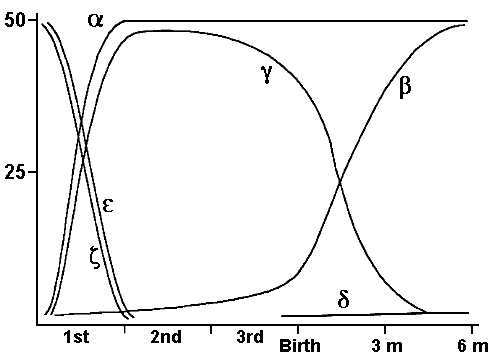|
Additional sections of this tutorial include:
Alpha thalassemias
Beta thalassemias
Sickle cell disease
Hemoglobin C and E diseases
Combinations of Hemoglobins S, C, E, and beta thalassemia
Miscellaneous conditions
References
Introduction

Red blood cells have the important function of carrying oxygen from lungs to body tissues. In order to perform this function, RBC's contain hemoglobin. Normal hemoglobin consists of four globin chains, each holding a heme molecule that contains iron. Globin is a complex protein containing a precise sequence of amino acids that allows it to fold into a complex conformational pattern. It is variations in the globin chains that leads to the hemoglobinopathies. These hemoglobinopathies may be due to alterations in certain globin chains that include:
- Absence of production
- Diminished production
- Abnormal structure
Normal Hemoglobin
A variety of globin chains can be present. Normally, the alpha and beta (and to a lesser extent the delta) globin chains form adult hemoglobin. In fetal life, the gamma, epsilon, and zeta chains are present.
Hemoglobin consists of pairs of these globin chains:
| Globin Chain | Location of Gene
| | alpha | Chromosome 16
| | beta | Chromosome 11
| | gamma | Chromosome 11
| | delta | Chromosome 11
| | epsilon | Chromosome 11
| | zeta | Chromosome 16
|
Formation of globin chains varies in fetal to adult life. The diagram below indicates the relative proportions (in % of total globin) of the various globin chains from conception to six months of age. Note that the epsilon and zeta chains are normally present only in the first trimester in utero.

Why do Hemoglobinopathies Exist?

Many of the hemoglobinopathies have arisen and attained some frequency because of malaria, a parasitic infection of red blood cells. The increased gene frequency of many hemoglobinopathies corresponds to the geographic distribution of malaria, including countries bordering the Mediterranean Sea, Africa, the Arabian peninsula, Asia, and Melanesia. The heterozygote form of these genetic variations affords a selective advantage to a person infected with Plasmodium, particularly the most virulent form Plasmodium falciparum, which may be lethal to persons with normal hemoglobin.
Hemoglobin Electrophoresis
Laboratory testing can aid in detection of hemoglobinopathies. Hemoglobin electrophoresis is often used for this purpose, because the migrational patterns of various hemoglobins are different. The button below leads to a demonstration of Hgb electrophoresis findings in a variety of normal and abnormal states.
|
 Return to the tutorial menu.
Return to the tutorial menu.